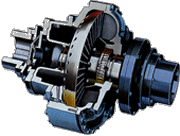 Controlling shaft misalignment is essential to optimum performance and protection of industrial equipment. If misalignment is not managed properly in power transmission equipment, you run the risk of deformations in the plastic, unpredictable vibrations, or even premature failure of the shaft or Falk coupling.
Controlling shaft misalignment is essential to optimum performance and protection of industrial equipment. If misalignment is not managed properly in power transmission equipment, you run the risk of deformations in the plastic, unpredictable vibrations, or even premature failure of the shaft or Falk coupling.
Shaft misalignment occurs when the center lines of coupled shafts do not match up. It’s important to understand and be able to identify which type of misalignment you are dealing with. Without understanding the types, it’s impossible to choose the right Falk coupling to manage the problem.
 1. Radial. Radial misalignment can also sometimes be referred to as parallel misalignment because the two shafts, or axes, are parallel but do not line up. A good analogy is two train tracks coming from opposite directions that are supposed to meet in the middle, but are offset.
1. Radial. Radial misalignment can also sometimes be referred to as parallel misalignment because the two shafts, or axes, are parallel but do not line up. A good analogy is two train tracks coming from opposite directions that are supposed to meet in the middle, but are offset.
 2. Angular. Angular misalignment involves an angle just as the name implies. It occurs when one of the shaft axes is at an angle in relation to the other. It’s as if you have a broken tree branch; if the lines of each shaft were extended, they would intersect, but are not parallel.
2. Angular. Angular misalignment involves an angle just as the name implies. It occurs when one of the shaft axes is at an angle in relation to the other. It’s as if you have a broken tree branch; if the lines of each shaft were extended, they would intersect, but are not parallel.
 3. Axial. An axial misalignment means the two ends of each axis, or shaft, don’t meet. They are parallel, but when fully extended, the ends do not come together. This kind of misalignment can also be called an end float because the ends of the shafts “float” but do not connect, meaning they can move in and out.
3. Axial. An axial misalignment means the two ends of each axis, or shaft, don’t meet. They are parallel, but when fully extended, the ends do not come together. This kind of misalignment can also be called an end float because the ends of the shafts “float” but do not connect, meaning they can move in and out.
While each of these mis-alignments has its own description, you will often get a combination of all three. Each of these three types of shaft misalignment can be managed with Falk couplings specifically designed to address the challenges they present. The correct Falk couplings should flex, rock, pivot or distort to accommodate shafts that aren’t aligned. Couplings need to connect shafts, transmit torque, accommodate misalignment and protect equipment. Your equipment will perform better and last longer with the proper Falk coupling.
Posted under Tips and Tricks on Monday, July 25th, 2011
